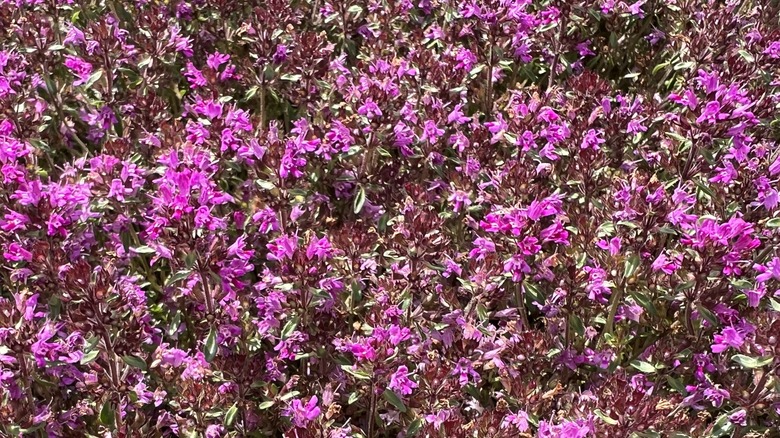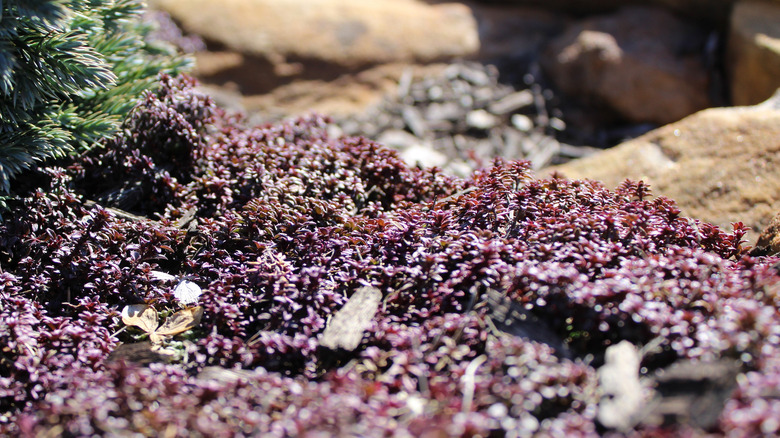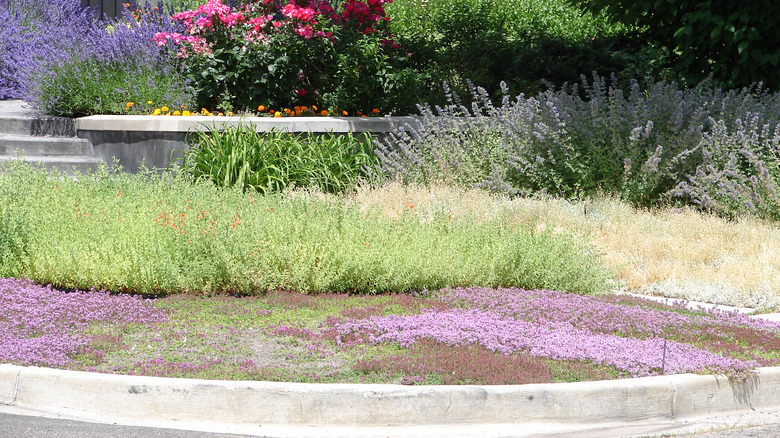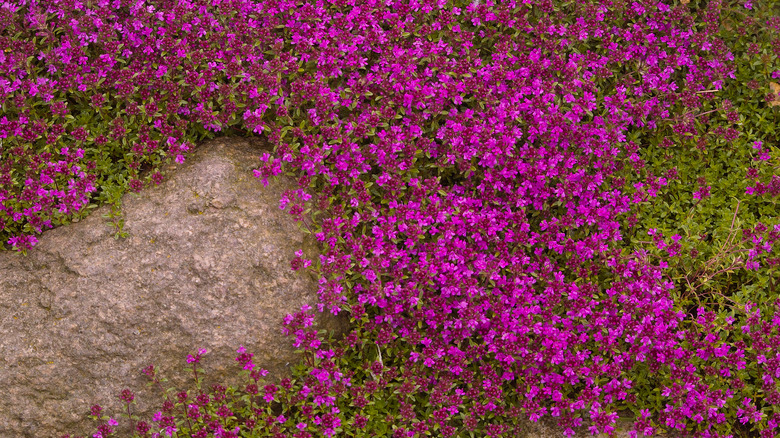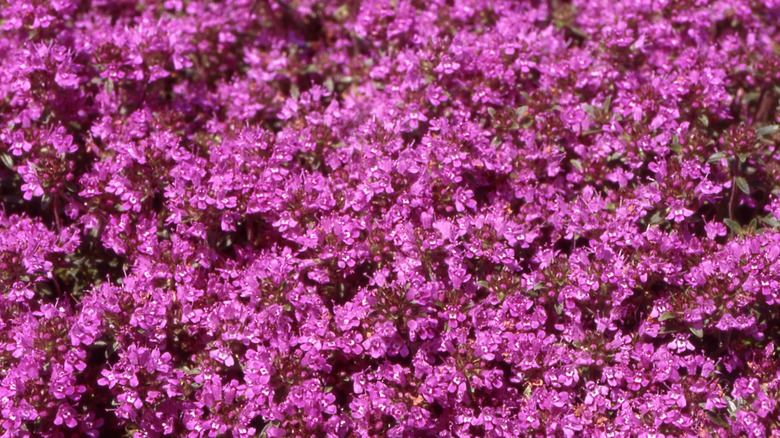Why You'll Love (And Hate) Planting Red Creeping Thyme In Your Yard
Red creeping thyme (Thymus praecox) is a stunning, brightly-colored plant in the mint family that's hardy in USDA zones 4 through 9. This groundcover can either be used to replace a green lawn or as a container plant. You'll love its natural ability to attract pollinators while repelling pests, as well as how easy it is to care for. However, you may want to second guess adding it to your yard because of the labor, time, and monetary investment that's involved when replacing an entire lawn and how far it can spread if not properly maintained.
This plant is highly-versatile in terms of where it can grow, as it doesn't require nutrient-rich or deep soil. However, it does prefer well-drained soil, as it could develop root rot if kept too wet. As a perennial, the red creeping thyme plant will come back each year. It does best in full sun but can handle some shaded areas, especially if they are in the path of more room to grow. Further, it can spread quickly across an area, as its tiny roots penetrate into the very top layers of the soil.
It supports pollinators and keeps pests away
Red creeping thyme is a pollinator attractant thanks to the abundance of nectar it offers. If you hope to bring in bees and butterflies to pollinate your vegetable garden or flowering plants, red creeping thyme will encourage them to visit. It will help your plants grow and may lead to a more bountiful harvest in your garden, as there will be more pollinators around. Groundcover plants like red creeping thyme can also provide a place for insects to live, so they may stick around your yard for a long time.
Additionally, while it welcomes beneficial critters, it also does a fantastic job of repelling typically-unwanted visitors like rabbits that could eat your greenery, flowers, and produce. Further, the mint-like taste of this plant is also a great way to deter deer. It also won't attract mosquitoes or rodents to your yard, as they don't enjoy the fragrance. Because of this, they may move on instead, allowing you to grow a lush garden and enjoy your backyard space in peace.
It's rather easy to care for
Red creeping thyme is rather simplistic to care for once it's in place. After the seedlings are planted, it will continue to expand on its own, requiring little support from you to do so. It's also drought tolerant, so it may require less water than grass typically does. Even better, it doesn't need to be mowed like grass. In fact, you may not want to mow it, as this may stimulate new growth and encourage the plant to spread too far.
As it spreads, red creeping thyme fills in all open areas, making it much harder for weeds to propagate within that space, which means that less overall work is needed to maintain your yard. Also, these plants don't require a lot of nutrients and can do well with just a balanced, well-draining soil. While it's a good idea to create a layer of freshly-tilled soil when establishing the plants, red creeping thyme doesn't demand fertilizers in most cases. Finally, it's durable, so a little bit of foot traffic won't harm your creeping thyme. However, while it's a strong plant, it can suffer some damage. Therefore, if you have areas you constantly walk on, use a barrier to minimize development and growth such as a concrete paver path.
Replacing a full lawn is labor intensive
If you have the time and budget, investing in red creeping thyme can be worthwhile, but you have to consider that this is a major project to get started in situations where you're replacing the entire lawn. To be clear, you can plant red creeping thyme in containers and even contain it within flowerbeds with a few helpful practices. However, many choose to plant it over their whole lawn instead as a way to ditch grass and to add something that is easy to care for once established.
Installing a red creeping thyme lawn requires removing the existing grass and building a foundation for the plant to thrive. While these plants don't need a lot of nutrition, they may do better starting with a good, loose, nutrient-rich, and pH-balanced soil. Because of this, you may need to add nutrients to the soil, especially if your soil is of the heavy clay-based variety. You may also need to place cardboard or landscape fabric down over your grass to kill it. Depending on how large your lawn is, this could be difficult and may take a long time. Another option is to place a layer of newspaper down, saturate it with water, and then layer it with mulch, as this will cause the grass to decompose so you can plant the red creeping thyme — but again, this may be a labor-intensive process.
The cost and time to establish can be frustrating
Another drawback to replacing your grass with red creeping thyme is the cost involved. The plant itself isn't expensive for small spaces, but it's going to cost significantly more to buy enough plants to fill the whole lawn. Further, it can take several seasons for it to fill in on its own. This means that, if you want to cover your entire lawn quickly, you'll need to purchase lots of plants to cover your whole yard. Aim to place them about a foot apart from each other to cover the space. The price per plant differs significantly based on where you purchase them, their age, and the size of the plants, but the costs can add up fast.
There are additional costs to consider as well. In order to prepare the soil, you might need the assistance of professionals to help you remove the lawn, and their services could be pricey. While killing the grass with herbicides would make the process faster and easier, you can't use an herbicide, as the toxins could remain in the soil and inhibit the thyme's growth. Additionally, the best way to give these plants a clear start is to remove all of the soil and create a fresh bed for them to grow from, which can take several months of prep work to complete. As hard as grass can be to grow, it's just as hard and time-consuming to fully remove.
You'll need to contain it well to maintain it
Before starting this project, carefully consider your end goal. If you want to use red creeping thyme as a grass alternative, you'll still need to create some type of barrier to prevent overspread, as your neighbors may not appreciate it. The same is true for garden areas and flowerbeds that you don't want to be covered with this herb. Keeping your red creeping thyme exactly where you want it can be difficult, but it's not impossible. Look into using hard surfaces like pavers or cement walkways or the installation of retaining walls. Otherwise, the plant will creep right into these other areas. If you want to contain it easily and aren't looking to replace your whole lawn with this plant, place it inside a container or garden pot, which will limit the spread of its roots.
While it does spread, creeping thyme isn't necessarily invasive in the full sense of the word. It doesn't harm other plants or overtake their space, growing more cohesively instead. That could make it an ideal choice for spaces you wish to fill in with a bold color but where you don't want to completely remove all plant life.
